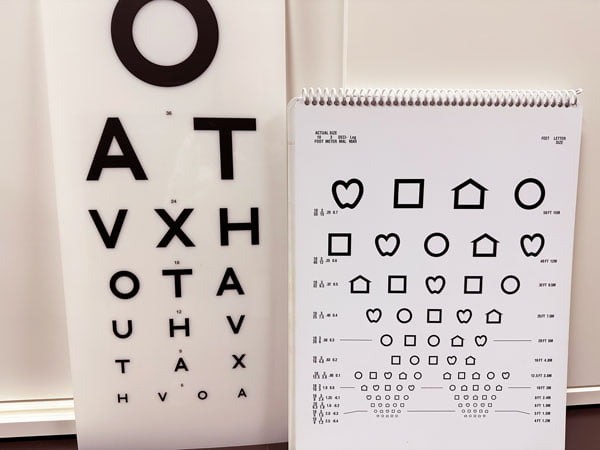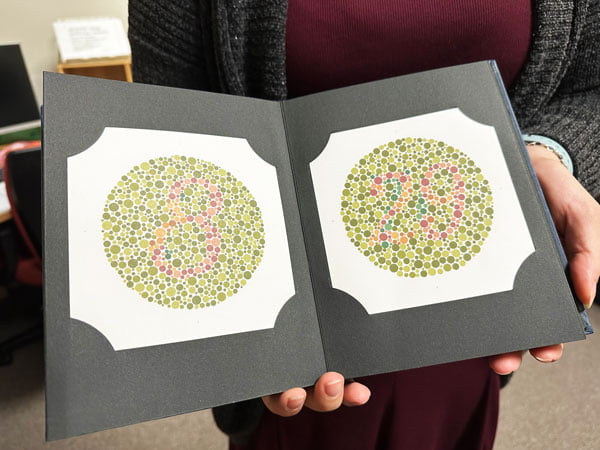If you’ve ever had an appointment with an orthoptist at VisAbility, you’ll know of the many diagnostic tests performed. These assess how a person uses their vision for everyday activities and learning.
They provide valuable information about potential issues or abnormalities. Based on the results of these tests, orthoptists can recommend assistive aids and therapies to address vision impairment issues.
Get support from the Orthoptics team
Do you know the purpose of each one? This guide will help.
Distance visual acuity
The distance visual acuity test indicates the clarity and sharpness of vision, whether someone can see finer details and objects at a distance.
If someone’s visual acuity is not within normal limits, it may indicate a need for prescription glasses (to correct for myopia or hyperopia), or hint at an eye condition e.g. cataracts or age related macular degeneration.
Orthoptists use a Snellen Chart (link opens in new window) to measure visual acuity. The chart consists of several lines of letters, each line decreasing in size. For children, we use symbols.
The results are in fraction form, such as 20/20 or 20/40. The first number represents the distance from the chart 20 feet (6 metres). The second number represents the distance a person with normal visual acuity could read that line of letters. If you can see smaller ones, then you have better eyesight.

Near visual acuity
Near visual acuity is relevant for tasks close by, such as reading and writing, while distance is crucial for driving and watching television. Measurements for both tests are done one eye at a time.
A near visual acuity test uses a chart consisting of paragraphs of text arranged in a specific order, with the large text located at the top and gradually decreasing in size as you move down the chart.
The chart determines text size that an individual can comfortably read at a close distance, typically around 14 to 16 inches (35 to 40 centimetres). The results are recorded, such as N6 or N8, where N represents Near with the number indicating size.

Contrast sensitivity
A contrast sensitivity test is a key indicator of functional vision and measures the ability to perceive sharp and clear outlines of very small objects. It measures a person’s ability to detect objects to distinguish them from their background contrast.
A series of patterns, shapes, or letters gradually decrease in contrast.
This type of test reveals vision problems undetectable through standard visual acuity testing. Certain eye conditions affect contrast sensitivity more than others, such as cataracts, glaucoma and macular degeneration.
Contrast sensitivity means orthoptists can identify subtle vision impairments that may impact activities in dimly lit areas.

Colour vision
A colour vision test recognises someone’s ability to distinguish different colours. Orthoptists use the Ishihara colour vision test (link opens in new window), consisting of a series of dots spelling out numbers in embedded coloured patterns.
The patterns are visible to people with normal colour vision but less distinguishable to anyone with colour vision deficiencies.
During the test, a patient identifies shapes or numbers they see in circles. The most common colour blindness is red-green. However, someone can have complete colour blindness.

Depth perception
A stereo-depth perception helps to determine the coordination and functionality of the eyes in three dimensions – length, width and depth. Someone with good depth perception can judge where an object is in the space around them. Both eyes can see the same object as one image to create a perception of depth.
The Stereo Fly Test (link opens in new window) checks stereo depth perception. The test is so-called because it centres on a large three-dimensional image of a fly. The individual has to pinch the tip of the wing while wearing glasses. The results indicate whether they can or cannot see in three dimensions and whether the eyes work effectively together.
This test, particularly suited for children, can pick up conditions like strabismus (misalignment of the eyes), amblyopia (lazy eye) and other visual abnormalities.

Ocular motility
The ocular motility test (link opens in new window) establishes the coordination and range of eye motion. It can assess whether the eye muscles work well together to control the movement of the eyes and track objects.
During this test, abnormalities or limitations in eye motion can be detected, such as strabismus (misalignment of the eyes), or nystagmus (involuntary eye movements).
The orthoptist will uses a pen torch as a fixation target and will ask the patient to follow the light with their eyes, into different gaze positions. It will just be their eyes that follow the light without moving the head. This allows the orthoptist to investigate the movement skills of each eye.
Visual fields
A visual field test evaluates and measures a person’s visual field, the peripheral vision. It can determine any vision loss in the corner of the eyes. Conditions like glaucoma and retinal diseases will impact the visual field.
The Bjerrum screen test measures visual acuity. Its name comes from its inventor, Danish ophthalmologist Jørgen Brøndsted Bjerrum.
The screen consists of a large white, concave hemispherical service with a black dot at the centre – the fixation point.
The patient is made to sit at a distance of one metre with their distance prescription glasses. The patient fixates on the centre of the Bjerrums mat. A white dot of 10mm in diameter is introduced to the mat from the periphery and slowly moved to the centre. The patient has to let the orthoptist know when they first see the dot.

How to get support
If you have a diagnosis of vision impairment, please contact our friendly team to find out what low vision services and support we can provide to you both now and into the future.
There are also a number of low vision support groups within Perth and across the state, which can connect you with like-minded people to build friendships and offer support.
If you are a provider and wish to refer a client, please use our low vision medical certificate (online referral form) to make your referral.
